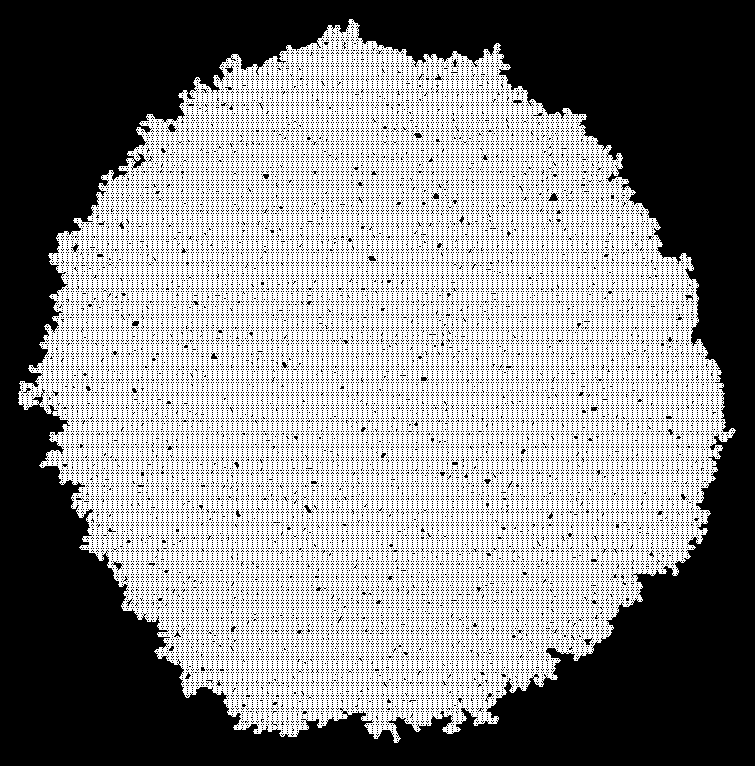I was curious about the OP's second question, which I now think is actually rather difficult. Namely
Why is it [the shape of a snowflake] not round?
Various physics-y sources (e.g. this paper) suggest the following "explanation" for the shape of a snowflake, which I mention in my comment on the original question--namely, that water crystallizes in a hexagonal lattice, so small snowflakes are just hexagons; new water molecules are more likely to attach at corners than edges or faces (for complicated reasons I don't really understand) so vertices grow faster than edges. Thus the hexagon will become a non-convex 6-pointed star; then the edges of this figure will split similarly, and so on. This interpretation is born out by e.g. the picture on pg. 884 of the paper above.
This inspired the following simple model, which comes in both deterministic and random flavors. We'll build a snowflake on the standard hexagonal lattice in $\mathbb{R}^2$, spanned by e.g. $(1, 0)$ and $(1/2, \sqrt{3}/2)$. Start with a single regular hexagon of side length $1$ centered at the origin, with vertices the six shortest lattice vectors.
In the deterministic version of the model, at each positive integer time $t$ we add a regular lattice hexagon with side length $1$ centered at each lattice point which is the vertex of exactly one hexagon. In the random version, at each positive integer time $t$, we add a hexagon centered at a random lattice point which is the vertex of exactly one hexagon with uniform probability over such lattice points.
I had some time this morning, so I coded up both models in the language "Processing." Here is a typical pair of snowflakes from the deterministic model:


This model has the following interesting properties, none of which are particularly difficult to prove.
1) By the envelope of a snowflake I mean the smallest simply-connected polygon containing it. Let $S_n$ be the envelope of the snowflake at time $n$. Consider the sequence $S_n$ in the space of plane polygons metrized by Hausdorff distance, modulo homothety (two polygons are homothetic if one is congruent to a rescaling of the other). Then $S_n$ is recurrent (that is, any homothety class visited by $S_n$ is approached arbitrarily closely infinitely many times). However, the only homothety class taken infinitely many times by the $S_n$ is that of a regular hexagon. (Thus in this setting the adage that no two snowflakes are alike is pretty far off.)
2) Let $H_n$ be the smallest regular hexagon containing $S_n$. Then $$\frac{\text{area}(S_n)}{\text{area}(H_n)}$$ is bounded above by $1$ and below by, say $1/2$ (though one can do better). By virtue of the recurrence of the $S_n$, however, this ratio does not attain a limit.
3) Certain interior triangles are never filled in, and as is visible in the pictures above these follow a beautiful regular pattern which I haven't bothered to work out.
Now let's look at the random model. Here are two typical snowflakes:


As you can see, these are quite round, so they might be better called snowballs. I understand this model much less well than the deterministic one above. However, the following conjectures are natural given the pictures.
4) (Conjecture) In the space of homothety classes of plane polygons, metrized by Hausdorff distance, as in (1) above, the envelopes of these shapes tend towards the homothety class of a circle with probability $1$.
5) (Conjecture) The ratio $$\frac{\text{perimiter}(S_n)}{\sqrt{\text{area}(S_n)}}$$ tends to infinity with probability $1$.
In other words--the random model I implicitly suggested in my comment on the original question seems to give round snowflakes! So I at least think the physics question as to why snowflakes aren't round is still pretty interesting.
In the comments, Rebecca Bellovin suggests another random model--namely, fix a probability $0\leq p\leq 1$ and at each time $t$, and each valid lattice point (namely, each lattice point which is the vertex of exactly one hexagon) add a hexagon centered at that point with probability $p$. At least for small $t$ (e.g. $t<10000$), this seems to interpolate between the two models I give here, and certainly if one scales $p$ in proportion to the number of valid lattice points (so that for example the probability is negligible that more than one hexagon will be added, or that no valid points will be missed), these models will behave exactly like the ones I give. On the other hand, for middling $p$, something interesting happens--namely, the snowflakes look like rounded hexagons. At Rebecca's request, I am posting a picture for $p=0.7$, below:

I have no real explanation for this phenomenon; only unconvincing heuristics.







